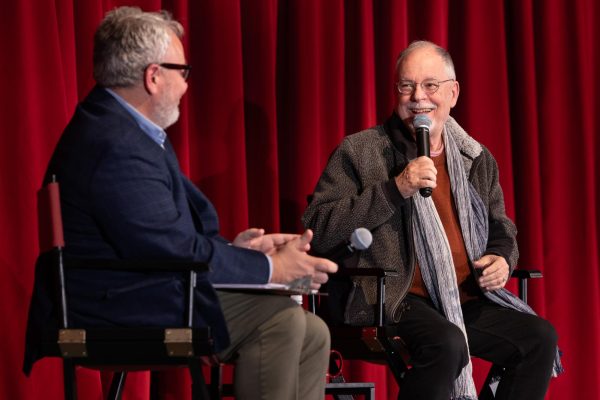Junior Researches Links Between Mental and Reproductive Health
Nora Thomas is researching diagnosis and treatment of illnesses based on gender in the 19th century
As many humanities researchers do when asked to describe their research, Nora Thomas, FCRH ’21, said hers was complicated. Thomas spent her summer juggling work at WFUV, Fordham’s on-campus NPR affiliate, and researching the modern day links between mental and reproductive health.
“When I initially started this project, I was wondering if syphilis had any effect on the medicalization of mental illness,” said Thomas. “In the 19th century, a lot of western medicine was codified in a different way, and doctors were espousing medical truths and making up biological justifications for societal viewpoints. So there’s a lot of really sketchy stuff going on with race and gender.”
Over the course of the summer, Thomas’s research evolved into a more formal question: “why did 19th century physicians create a disease analogous to hysteria but without the derogatory connotations (i.e., femaleness)?”
She spent the summer reading and combing through archives which led her to the medical records of Charles Loomis Dana, a neurologist from the 1860s.
According to Thomas, Dana developed a disease called neurasthenia that became prevalent between 1870 and 1910. Neurasthenia was diagnosed almost exclusively in the United States and became known as the American disease.
“It sounds weird to talk about a disease as if it were developed, but all of this is a construction of the English language and what people believe,” said Thomas. “All the illnesses that we experience to a certain extent are a societal construction.”
The symptoms and treatment for neurasthenia were similar to that of hysteria, a psychological disorder of the time that was mostly diagnosed in women and was characterized by over-emotion. Neurasthenia was only diagnosed in high class men with jobs that required mental strain. It stemmed from the belief that seemingly intelligent men such as doctors and professors were exhausting their nerves by thinking too much.
With a second FCRH research grant, Thomas is writing a research paper answering the aforementioned question about the diagnosis and treatment of illnesses.
Thomas said she has learned a lot throughout her research. She started by simply questioning a trend she had seen in her own life. She asked why, presently, there are so many women prescribed birth control for mental health problems when antidepressants often provide a better solution.
“My objection isn’t that this is all psuedo-science,” said Thomas. “My objection is that the same thing isn’t the case for men. No one is like, ‘Oh, you have depression? Your testicles aren’t working.’ Whereas if women have hormonal disorders, it’s always attributed to their ovaries. It doesn’t mean that isn’t true, I’m just asking why women are still seen as creatures of their reproductive system and men aren’t.”
Thomas learned about and hopes to explore the development of western medicine in America. She said that the United States is the birthplace of gynecology.
“We have a long history of unnecessary surgeries, particularly on women’s reproductive organs,” said Thomas. “In my research I saw a statistic that said a third of women in their 60s had hysterectomies.”
She also said she’s discovered many medical advancements that were the results of the exploitation of women’s bodies.
Thomas believes neurasthenia and hysteria were part of an effort to explain mental breakdowns, and our more sophisticated understanding of mental illness today would define them as depression, anxiety or other similar disorders.
“These problems have always existed, it’s just when certain groups have the means to address them that they get talked about,” said Thomas. “So these rich Americans had a need, and because they were influential, they were able to seek out treatment.”
One of the differences between neurasthenia and hysteria that Thomas identified were the extent of the treatments. Men had work hours shortened while women were isolated from their families and given almost nothing to do.
“Doctors were using medicine to confine people to their expected roles, and poor people and people of color were expected to work manual labor and things that didn’t involve the brain,” said Thomas. “This medical description was, in part, a way to combat elements of progressivism that were changing roles for people.”
This semester, Thomas is also a part of the Mannion Society, a history society at Fordham that does archival research. Thomas said she appreciates the hard deadlines they provide her, as well as what she has learned from it.
“I’m learning all the time that there’s all these resources through the library that I didn’t even know about,” said Thomas. “There’s so much more I could have done this summer, like utilize the Library of Congress. I was just very limited because I didn’t have a complete understanding of how to access these things.”
Thomas said she wants anyone doing research to utilize the Fordham library and ask questions.














































































































































































































David Young • Oct 10, 2019 at 5:36 pm
Neurasthenia is a really cool topic. I suggest Nora reviews a book called The Invisible Rainbow by Arthur Firstensburg. I think she would really enjoy it. Skip the chapter on ears — too complicated. This is my review:
• The Invisible Rainbow: A History of Electricity and Life (2017, 387 pages) is one of the most intriguing and frightening books I have ever read. A supporting associated website is available. This pioneering work of Arthur Firstenberg was clearly years in the making with 387 pages compelling of text and another 150 in supporting notes, index, and bibliography. While the subject matter may elicit memories of science and history classes it is artfully woven to inspire and capture the reader. Examining worldwide history (starting in the mid 1700s) of electricity and its impact on human, plant, insect, and animal life was clearly a challenge that Firstenberg should be proud of. The forgotten history of neurasthenia, Leyden jars, and spread of electrification foreshadows the impact of telegraph, telephone, radio, radar, and microwaves on communication, trade, public health, animal life, and military efforts such as HAARP. Firstenberg’s masterpiece spans the globe for research and insight from America, Europe, Russia, and Germany. The observational skill and inquisitive prowess of select doctors, scientists, and even beekeepers across two hundred years provide a convincing backdrop which keeps the reader captivated. The author brilliantly expands on Dr. Samuel Milham’s epidemiological research on cancer, heart disease, and diabetes. The discussion of influenza and its suspected relationship to electricity and military history is stunning. The insights on colony collapse disorder, tinnitus, cell phones, and global radiation are prophetic. Every physician, physicist, politician, and parent should read The Invisible Rainbow. I was disheartened after learning of the authors opinions via email regarding colloidal silver, magnesium, RIFE, PEMF as they differ greatly than mine. This was surprising given his exacting scientific reference and research capability.